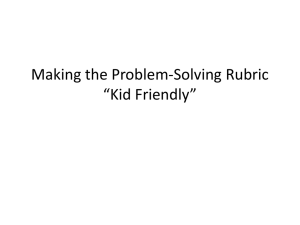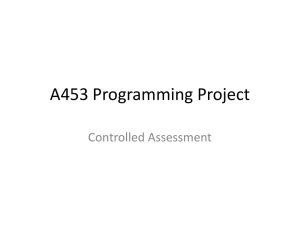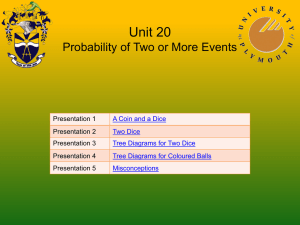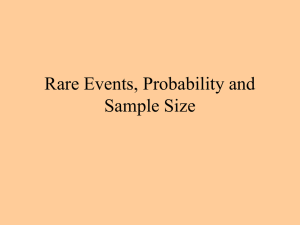Homework3-Solution
advertisement
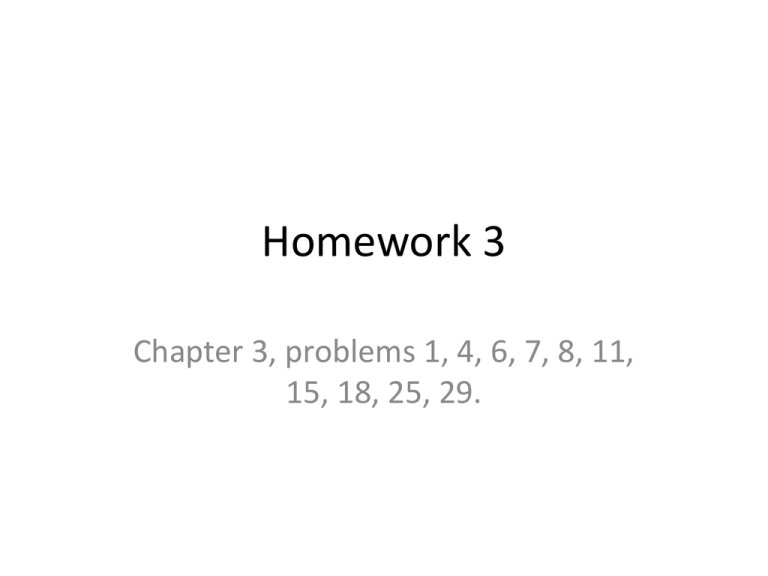
Homework 3
Chapter 3, problems 1, 4, 6, 7, 8, 11,
15, 18, 25, 29.
• 3.1 Two fair dice are rolled. What is the conditional probability that
at least one lands on 6 given that the dice land on different
numbers?
• A: at least one lands on 6
• B: the dice land on different numbers
• S: the sample space of two dice rolling contains 36 outcomes
• P(A|B) = P(AB)/P(B)
• AB: at least one lands on 6 and the dice land on different numbers
– (1, 6), (2, 6), (3, 6), (4, 6), (5, 6), (6, 1), (6, 2), (6, 3), (6, 4), (6, 5)
• P(AB) = num. of outcomes in AB / total num. of outcomes in S =
10/36
• B: the dice land on different numbers
– Number of outcomes in B is 36 – number of dice land on the same
numbers
• 36 - 6 = 30
• P(B) = 30/36 = 5/6
• P(A|B) = (10/36)/(5/6) = 1/3
• 3.4 What is the probability that at least one of a pair of fair dice lands on
6, given that the sum of the dice is i, i = 2, 3, . . . , 12?
• A: at least one of the dice lands on 6.
• B: the sum of the dice is i.
• S: sample space with totally 36 outcomes
• P(A|B) = P(AB)/P(B)
• AB: at least one of the dice lands on 6 and the sum of dice is i.
– AB = when i = 2, 3, 4, 5, 6.
• P(AB) = 0 for i = 2, 3, 4, 5, 6.
– AB = {(1,6) (6,1)} when i = 7; AB = {(2,6)(6,2)} when i = 8...
• P(AB) = 2/36 for i = 7, 8, 9, 10, 11
– AB = {(6,6)} when i = 12
• P(AB) = 1/36 for i = 12.
• B: the sum of the dice is i.
– B = {(1,6) (2,5) (3,4) (4,3) (5,2) (6,1)} when i = 7, P(B) = 1/6
– B = {(2,6), (3,5) (4,4) (5,3) (6,2)} when i = 8, P(B) = 5/36
• P(B) = 4/36 (i=9), 3/36 (i=10), 2/36 (i=11), 1/36 (i=12).
• P(A|B) = P(AB)/P(B)
– (2/36)/(1/6) = 1/3 for i=7
– (2/36)/(5/36) = 2/5 for i=8
– 2/4 (i=9), 2/3 (i=10), 1 (i=11), 1 (i=12).
• 3.6. Consider an urn containing 12 balls, of which 8 are white and 4 are
black. A sample of size 4 is to be drawn with replacement (without
replacement). What is the conditional probability (in each case) that the
first and third balls drawn will be white given that the sample drawn
contains exactly 3 white balls?
• A: the first and third balls are white.
• B: the sample drawn contains exactly 3 white balls.
• P(A|B) = P(AB)/P(B)
• AB: The first and third balls are white and the sample contains exactly 3
white balls
– Only two possibilities: W B W W and W W W B
– B: The sample contains exactly 3 white balls
– Four possibilities: B W W W, W B W W, W W B W, W W W B
• With replacement
– P(AB) = (8/12)*(4/12)*(8/12)*(8/12) + (8/12)*(8/12)*(8/12)*(4/12) =
(8/12)*(4/12)*(8/12)*(8/12) * 2 = 16/81
– P(B) = (8/12)*(4/12)*(8/12)*(8/12)*4 = 32/81
– P(A|B) = 1/2
• Without replacement
– P(AB) = (8/12)*(7/11)*(6/10)*(4/9) + (8/12)*(4/11)*(7/10)*(6/9) =
(8/12)*(7/11)*(6/10)*(4/9)*2
– P(B) = (8/12)*(7/11)*(6/10)*(4/9)*4
– P(A|B) = 1/2
• 3.7. The king comes from a family of 2 children. What
is the probability that the other child is his sister?
• The probability that the other child is his sister =
probability that the other child is female (one male and
one female) given one is male (king)
• A: one child is a male and one child is a female
• B: one child is a male
• P(A|B) = P(AB)/P(B)
• AB is the same event as A: one child is a male and one
child is a female
• P(AB) = P(A) = P({M,F},{F,M}) = 1/2
• P(B) = P({M,F},{F,M},{M,M}) = 3/4
• P(A|B) = 2/3
• 3.8. A couple has 2 children. What is the
probability that both are girls if the older of
the two is a girl?
• A: both are girls
• B: the older of the two is a girl
• P(A|B) = P(AB)/P(B)
• AB: Both are girls
• P(AB) = P({G,G}) = 1/4
• P(B) = P({G,B}, {G,G}) = 1/2
• P(A|B) = 1/2
• 3.11. Two cards are randomly chosen without
replacement from an ordinary deck of 52 cards. Let B
be the event that both cards are aces, let As be the
event that the ace of spades is chosen, and let A be the
event that at least one ace is chosen. Find (a) P(B|As)
(b) P(B|A).
• P(B|As) = P(BAs)/P(As)
• BAs: both cards are aces and ace of spades is chosen
• P(BAs) = (1/52)*(3/51)+(3/52)(1/51) = 6/(51*52)
• P(As) = 1/52 + (51/52)*(1/51) = 2/52
• P(B|As) = 3/51 = 1/17
• BA: both cards are aces
• P(BA) = (4/52)*(3/51) = 12/(51*52)
• P(A) = 1-((48/52)(47/51)) = (52*51-48*47)/(51*52)
• P(B|A) = P(AB)/P(A) = 12/396 = 1/33
• 3.15. An ectopic pregnancy is twice as likely to develop when the
pregnant woman is a smoker as it is when she is a nonsmoker. If 32
percent of women of childbearing age are smokers, what
percentage of women having ectopic pregnancies are smokers?
• Probability of a woman being a smoker given she has ectopic
pregnancy
• E: ectopic pregnancy
• S: smoker
• P(S|E)?
• P(E|S) = 2*P(E|Sc)
• P(S) = 0.32
• P(S|E) = P(SE)/P(E)
• SE: has ectopic pregnancy and is a smoker
• P(SE) = P(E|S)P(S)
• P(E) = P(E|S)P(S) + P(E|Sc)P(Sc)
• P(S|E) = P(E|S)P(S) / (P(E|S)P(S) + P(E|Sc)P(Sc))
= P(E|S)P(S) / (P(E|S)P(S) + 1/2P(E|S)P(Sc))
=P(S)/(P(S) + 1/2P(Sc)) = 0.32/(0.32+0.5*0.68) = 0.4848
• 3.18. A total of 46 percent of the voters in a certain city classify
themselves as Independents, whereas 30 percent classify
themselves as Liberals and 24 percent say that they are
Conservatives. In a recent local election, 35 percent of the
Independents, 62 percent of the Liberals, and 58 percent of the
Conservatives voted. A voter is chosen at random. Given that this
person voted in the local election, what is the probability that he or
she is
• (a) an Independent?
• (b) a Liberal?
• (c) a Conservative?
• (d) What fraction of voters participated in the local election?
• P(I|V), P(L|V), P(C|V), P(V)
P(I|V) = P(IV)/P(V) = P(V|I)P(I)/(P(V|I)P(I)+P(V|L)P(L)+P(V|C)P(C))
= .35*.46/(.35*.46+.62*.30+.58*.24) = .161/.4862 = .3311
P(L|V) = P(V|L)P(L) / P(V) = .62*.30/.4862 = .38256
PC|V) = P(V|C)P(C) / P(V) = .58*.24/.4862 = .2863
P(V) = .4862
3.25. The following method was proposed to
estimate the number of people over the age of 50
who reside in a town of known population 100,000:
“As you walk along the streets, keep a running
count of the percentage of people you encounter
who are over 50. Do this for a few days; then
multiply the percentage you obtain by 100,000 to
obtain the estimate.” Comment on this method.
Hint: Let p denote the proportion of people in the
town who are over 50. Furthermore, let α1 denote
the proportion of time that a person under the age
of 50 spends in the streets, and let α2 be the
corresponding value for those over 50. What
quantity does the method suggested estimate?
When is the estimate approximately equal to p?
• Let F denote the event that a person is over fifty and denote this
probability by p which is also the number we desire to estimate. Let
α1 denote the proportion of the time a person under fifty spends on
the streets and α2 the same proportion for people over fifty. Let S
denote the event that a person (of any age) is found in the streets.
Then this event S can be decomposed into the sets where the
person on the streets is less than or greater than fifty as S = SF SFc
• P(F) = p
• P(S|F) = α2, P(S|Fc)= α1
• P(S) = P(SF) + P(SFc).
• P(SF) = P(F)P(S|F) = pP(S|F)
• P(SFc) = P(Fc)P(S|Fc) = (1 − p)P(S|Fc) .
• We are measuring P(F|S)
• P(F|S) = P(S|F)P(F) / (P(SF) + P(SFc))
= P(S|F)P(F) / (pP(S|F) + (1 − p)P(S|Fc) )
= α2p/(α2p + α1(1 − p))
When α1 = α2 we have P(F|S) = p
• 3.29. There are 15 tennis balls in a box, of which 9 have not
previously been used. Three of the balls are randomly
chosen, played with, and then returned to the box. Later,
another 3 balls are randomly chosen from the box. Find the
probability that none of these balls has ever been used.
• Let A be the event none of the balls in second draw has
ever been used
• Let E0, E1, E2, and E3 be the events we selected 0, 1, 2, and 3
used balls during our first draw.
3
P ( A)
P( A | E )P(E )
i
i
i0
69
03
P (E0 )
,
15
3
69
21
P(E2 )
,
15
3
69
12
P ( E1 )
15
3
69
30
P ( E3 )
15
3
96
03
P ( A | E0 )
,
15
3
87
03
P ( A | E1 )
15
3
78
03
P( A | E2 )
,
15
3
69
03
P ( A | E3 )
15
3
P ( A ) 0.0893

